Gr/3D–ZnO Nanocomposites as Humidity Sensors with Enhanced Sensing Response
Abstract
1. Introduction
2. Experimental
2.1. Materials
2.2. Fabrication of Gr/3D–ZnO Nanocomposite Material
2.3. Characterization
2.4. Sensor Fabrication and Humidity Testing
3. Results and Discussion
3.1. Characterization of the Nanocomposite Structure
3.2. Sensitivity to Humidity
3.3. Sensing Mechanism
4. Conclusions
Author Contributions
Funding
Institutional Review Board Statement
Informed Consent Statement
Conflicts of Interest
References
- Lee, C.-Y.; Lee, G.-B. Humidity sensors: A review. Sens. Lett. 2005, 3, 1–15. [Google Scholar] [CrossRef]
- Blank, T.A.; Eksperiandova, L.P.; Belikov, K.N. Recent trends of ceramic humidity sensors development: A review. Sens. Actuators B Chem. 2016, 228, 416–442. [Google Scholar] [CrossRef]
- Divya, T.; Nikhila, M.P.; Anju, M.; Arsha Kusumam, T.V.; Akhila, A.K.; Ravikiran, Y.T.; Renuka, N.K. Nanoceria based thin films as efficient humidity sensors. Sens. Actuators A Phys. 2017, 261, 85–93. [Google Scholar] [CrossRef]
- Meng, W.; Wu, S.; Wang, X.; Zhang, D. High-sensitivity resistive humidity sensor based on graphitic carbon nitride nanosheets and their application. Sens. Actuators B Chem. 2020, 315, 128058. [Google Scholar] [CrossRef]
- Ruiz, V.; Fernández, I.; Carrasco, P.; Cabañero, G.; Grande, H.J.; Herrán, J. Graphene quantum dots as a novel sensing material for low-cost resistive and fast-response humidity sensors. Sens. Actuators B Chem. 2015, 218, 73–77. [Google Scholar] [CrossRef]
- Mallick, S.; Ahmad, Z.; Qadir, K.W.; Rehman, A.; Shakoor, R.A.; Touati, F.; Al-Muhtaseb, S.A. Effect of BaTiO3 on the sensing properties of PVDF composite-based capacitive humidity sensors. Ceram. Int. 2020, 46, 2949–2953. [Google Scholar] [CrossRef]
- Qi, R.; Zhang, T.; Guan, X.; Dai, J.; Liu, S.; Zhao, H.; Fei, T. Capacitive humidity sensors based on mesoporous silica and poly(3,4-ethylene dioxythiophene) composites. J. Colloid Interface Sci. 2020, 308, 127693. [Google Scholar]
- Qi, P.; Xu, Z.; Zhang, T.; Fei, T.; Wang, R. Chitosan wrapped multiwalled carbon nanotubes as quartz crystal microbalance sensing material for humidity detection. J. Colloid Interface Sci. 2020, 560, 284–292. [Google Scholar] [CrossRef] [PubMed]
- Qi, P.; Zhang, T.; Shao, J.; Yang, B.; Fei, T.; Wang, R. A QCM humidity sensor constructed by graphene quantum dots and chitosan composites. Sens. Actuators A Phys. 2019, 287, 93–101. [Google Scholar] [CrossRef]
- Sun, Y.L.; Chen, Y.Z.; Wu, R.J.; Chavali, M.; Huang, Y.C.; Su, P.G.; Lin, C.C. Poly(l-lactide) stabilized gold nanoparticles based QCM sensor for low humidity detection. Sens. Actuators B Chem. 2007, 126, 441–446. [Google Scholar] [CrossRef]
- Ascorbe, J.; Corres, J.M.; Matias, I.R.; Arregui, F.J. High sensitivity humidity sensor based on cladding-etched optical fiber and lossy mode resonances. Sens. Actuators B Chem. 2016, 233, 7–16. [Google Scholar] [CrossRef]
- Yuan, T.; Qi, X.; Liu, Z.; Yang, J.; Guan, C.; Long, Q.; Cao, J.; Luo, M.; Yang, X.; Yuan, L. Humidity sensor based on micro-optical fiber array fabricated by electrospinning. Opt. Commun. 2018, 427, 517–521. [Google Scholar] [CrossRef]
- Kuznetsova, I.E.; Anisimkin, V.I.; Kolesov, V.V.; Kashin, V.V.; Osipenko, V.A.; Gubin, S.P.; Tkachev, S.V.; Verona, E.; Sun, S.; Kuznetsova, A.S. Sezawa wave acoustic humidity sensor based on graphene oxide sensitive film with enhanced sensitivity. Sens. Actuators B Chem. 2018, 272, 236–242. [Google Scholar] [CrossRef]
- Tang, Y.; Li, Z.; Ma, J.; Wang, L.; Yang, J.; Du, B.; Yu, Q.; Zu, X. Highly sensitive surface acoustic wave (SAW) humidity sensors based on sol-gel SiO2 films: Investigations on the sensing property and mechanism. Sens. Actuators B Chem. 2015, 215, 283–291. [Google Scholar] [CrossRef]
- Wu, R.J.; Sun, Y.L.; Lin, C.C.; Chen, H.W.; Chavali, M. Composite of TiO2 nanowires and nafion as a humidity sensor material. Sens. Actuators B Chem. 2006, 115, 198–204. [Google Scholar] [CrossRef]
- Liang, F.; Luo, L.-B.; Tsang, C.-K.; Zheng, L.; Cheng, H.; Li, Y.Y. TiO2 nanotube-based field-effect transistors and their application as humidity sensors. Mater. Res. Bull. 2012, 47, 54–58. [Google Scholar] [CrossRef]
- Park, S.; Lee, D.; Kwak, B.; Lee, H.-S.; Lee, S.; Yoo, B. Synthesis of self-bridged ZnO nanowires and their humidity sensing properties. Sens. Actuators B Chem. 2018, 268, 293–298. [Google Scholar] [CrossRef]
- Parthibavarman, M.; Karthik, M.; Prabhakaran, S. Facile and one-step synthesis of WO3 nanorods and nanosheets as an efficient photocatalyst and humidity sensing material. Vacuum 2018, 155, 224–232. [Google Scholar] [CrossRef]
- Adhyapak, P.V.; Kadam, V.; Mahadik, U.; Amalnerkar, D.P.; Mulla, I.S. Influence of Li doping on the humidity response of maghemite (γ-Fe2O3) nanopowders synthesized at room temperature. Ceram. Int. 2013, 39, 8153–8158. [Google Scholar] [CrossRef]
- Li, Z.-Y.; Yang, W.-J.; Wu, Y.-P.; Wu, S.-B.; Cai, Z.-B. Role of humidity in reducing the friction of graphene layers on textured surfaces. Appl. Surf. Sci. 2017, 403, 362–370. [Google Scholar] [CrossRef]
- Liou, H.J.; Suyambrakasam, G.; Tsai, T.C.; Wu, R.J.; Chavali, M. Preparation of nanostructured organic/inorganic polymer hybrids and their humidity sensing properties. J. Taiwan Inst. Chem. Eng. 2011, 42, 868–873. [Google Scholar] [CrossRef]
- Wang, Z.; Lu, Y.; Yuan, S.; Shi, L.; Zhao, Y.; Zhang, M.; Deng, W. Hydrothermal synthesis and humidity sensing properties of size-controlled Zirconium Oxide (ZrO2) nanorods. J. Colloid Interface Sci. 2013, 396, 9–15. [Google Scholar] [CrossRef] [PubMed]
- Pascariu, P.; Airinei, A.; Olaru, N.; Petrila, I.; Nica, V.; Sacarescu, L.; Tudorache, F. Microstructure, electrical and humidity sensor properties of electrospun NiO–SnO2 nanofibers. Sens. Actuators B Chem. 2016, 222, 1024–1031. [Google Scholar] [CrossRef]
- Arularasu, M.V.; Harb, M.; Vignesh, R.; Rajendran, T.V.; Sundaram, R. PVDF/ZnO hybrid nanocomposite applied as a resistive humidity sensor. Surf. Interfaces 2020, 21, 100780. [Google Scholar] [CrossRef]
- Hsu, C.-L.; Chang, L.-F.; Hsueh, T.-J. Light-activated humidity and gas sensing by ZnO nanowires grown on LED at room temperature. Sens. Actuators B Chem. 2017, 249, 265. [Google Scholar] [CrossRef]
- Dwiputra, M.A.; Fadhila, F.; Imawan, C.; Fauzia, V. The enhanced performance of capacitive-type humidity sensors based on ZnO nanorods/WS2 nanosheets heterostructure. Sens. Actuators B Chem. 2020, 310, 127810. [Google Scholar] [CrossRef]
- Modaresinezhad, E.; Darbar, S. Realization of a room-temperature/self-powered humidity sensor, based on ZnO nanosheets. Sens. Actuators B Chem. 2016, 237, 358–366. [Google Scholar] [CrossRef]
- Niarchos, G.; Dubourg, G.; Afroudakis, G.; Tsouti, V.; Makarona, E.; Matović, J.; Crnojević-Bengin, V.; Tsamis, C. Paper-based Humidity Sensor Coated with ZnO Nanoparticles: The Influence of ZnO. Procedia Eng. 2016, 168, 325. [Google Scholar] [CrossRef]
- Lin, Q.; Li, Y.; Yang, M. Investigations on the sensing mechanism of humidity sensors based on electrospun polymer nanofibers. Sens. Actuators B Chem. 2012, 171–172, 309–314. [Google Scholar] [CrossRef]
- Perfecto, T.M.; Zito, C.A.; Volanti, D.P. Effect of NiS nanosheets on the butanone sensing performance of ZnO hollow spheres under humidity conditions. Sens. Actuators B Chem. 2021, 334, 129684. [Google Scholar] [CrossRef]
- Zhu, D.; Ma, H.; Zhen, Q.; Xin, J.; Tan, L.; Zhang, C.; Wang, X.; Xiao, B. Hierarchical flower-like zinc oxide nanosheets in-situ growth on three-dimensional ferrocene-functionalized graphene framework for sensitive determination of epinephrine and its oxidation derivative. Appl. Surf. Sci. 2020, 526, 146721. [Google Scholar] [CrossRef]
- Feng, M.H.; Wang, W.C.; Li, X.J. Capacitive humidity sensing properties of CdS/ZnO sesame-seedcandy structure grown on silicon nanoporous pillar array. J. Alloys Compd. 2017, 698, 94–98. [Google Scholar] [CrossRef]
- Zhang, H.; Yu, S.; Chen, C.; Zhang, J.; Liu, J.; Li, P. Effects on structure, surface oxygen defects and humidity performance of Au modified ZnO via hydrothermal method. Appl. Surf. Sci. 2019, 486, 482–489. [Google Scholar] [CrossRef]
- Yin, P.T.; Kim, T.-H.; Choi, J.-W.; Lee, K.-B. Prospects for graphene-nanoparticle-based hybrid sensors. Phys. Chem. Chem. Phys. 2013, 15, 12785. [Google Scholar] [CrossRef]
- Latif, U.; Dickert, F. Graphene hybrid materials in gas sensing applications. Sensors 2015, 15, 30504–30524. [Google Scholar] [CrossRef]
- Son, Y.J.; Chun, K.Y.; Kim, J.S.; Lee, J.H.; Han, C.S. Effects of chemical and physical defects on the humidity sensitivity of graphene surface. Chem. Phys. Lett. 2017, 689, 206–211. [Google Scholar] [CrossRef]
- Lin, C.-H.; Chen, W.-T.; Huang, C.-H.; Woon, W.-Y.; Lin, C.-T. Effects of π-electron in humidity sensing of artificially stacked graphene bilayers modified with carboxyl and hydroxyl groups. Sens. Actuators B Chem. 2019, 301, 127020. [Google Scholar] [CrossRef]
- Su, Y.; Li, C.; Li, M.; Li, H.; Xu, S.; Qian, L.; Yang, B. Surface acoustic wave humidity sensor based on three-dimensional architecture graphene/PVA/SiO2 and its application for respiration monitoring. Sens. Actuators B Chem. 2020, 308, 127693. [Google Scholar] [CrossRef]
- Ali, S.; Hassan, A.; Hassan, G.; Bae, J.; Lee, C.H. All-printed humidity sensor based on graphene/methyl-red composite with high sensitivity. Carbon 2016, 105, 23–32. [Google Scholar] [CrossRef]
- Kilic, B.; Turkdogan, S. Fabrication of dye-sensitized solar cells using graphene sandwiched 3D–ZnO nanostructures based photoanode and Pt-free pyrite counter electrode. Mater. Lett. 2017, 193, 195. [Google Scholar] [CrossRef]
- Huang, Y.; Chen, X.; Zhang, K.; Feng, X. Preparation of graphene supported flower-like porous 3D ZnO–NiO ternary composites for high capacity anode materials for Li-ion batteries. Ceram. Int. 2015, 41, 13532. [Google Scholar] [CrossRef]
- Lin, W.-D.; Chang, H.-M.; Wu, R.-J. Humidity sensing properties of ZnO colloid crystals coated on quartz crystal microbalance by the self-assembly method. Ceram. Int. 2013, 181, 326–331. [Google Scholar]
- Lin, W.-D.; Liao, C.-T.; Chang, T.-C.; Chen, S.-H.; Wu, R.-J. Humidity sensing properties of novel graphene/TiO2 composites by sol-gel process. Sens. Actuators B Chem. 2015, 209, 555–561. [Google Scholar] [CrossRef]
- Zhang, D.; Chang, H.; Li, P.; Liu, R.; Xue, Q. Fabrication and characterization of an ultrasensitive humidity sensor based on metal oxide/graphene hybrid nanocomposite. Sens. Actuators B Chem. 2016, 225, 233–240. [Google Scholar] [CrossRef]
- Jlassi, K.; Mallick, S.; Eribi, A.; Chehimi, M.M.; Ahmad, Z.; Touati, F.; Krupa, I. Facile preparation of N-S co-doped graphene quantum dots (GQDs) from graphite waste for efficient humidity sensing. Sens. Actuators B Chem. 2021, 328, 129058. [Google Scholar] [CrossRef]
- Basnet, P.; Chatterjee, S. Structure-directing property and growth mechanism induced by capping agents in nanostructured ZnO during hydrothermal synthesis—A systematic review. Nano-Struct. Nano-Objects 2020, 22, 100426. [Google Scholar] [CrossRef]
- Yu, S.; Zhang, H.; Chen, C.; Lin, C. Investigation of humidity sensor based on Au modified ZnO nanosheets via hydrothermal method and first principle. Sens. Actuators B Chem. 2019, 287, 526–534. [Google Scholar] [CrossRef]
- Gu, L.; Zheng, K.; Zhou, Y.; Li, J.; Mo, X.; Patzke, G.R.; Chen, G. Humidity sensors based on ZnO/TiO2 core/shell nanorod arrays with enhanced sensitivity. Sens. Actuators B Chem. 2011, 159, 1–7. [Google Scholar] [CrossRef]
- Shao, S.; Kim, H.W.; Kim, S.S.; Chen, Y.; Lai, M. NGQDs modified nanoporous TiO2/graphene foam nanocomposite for excellent sensing response to formaldehyde at high relative humidity. Appl. Surf. Sci. 2020, 516, 145932. [Google Scholar] [CrossRef]
- Li, Y.; Deng, C.; Yang, M. Facilely prepared composites of polyelectrolytes and graphene as the sensing materials for the detection of very low humidity. Sens. Actuators B Chem. 2014, 194, 51–58. [Google Scholar] [CrossRef]
- Zhang, L.; Zhang, J.; Huang, Y.; Xu, H.; Zhang, X.; Lu, H.; Xu, K.; Chu, P.K.; Ma, F. Hexagonal ZnO nanoplates/graphene composites with excellent sensing performance to NO2 at room temperature. Appl. Surf. Sci. 2021, 537, 147785. [Google Scholar] [CrossRef]
- Kumar, P.; Som, S.; Pandey, M.K.; Das, S.; Chanda, A.; Singh, J. Investigations on optical properties of ZnO decorated graphene oxide (ZnO@GO) and reduced graphene oxide (ZnO@r-GO). J. Alloys Compd. 2018, 744, 64–74. [Google Scholar] [CrossRef]
- Nakrela, A.; Benramdane, N.; Bouzidi, A.; Kebbab, Z.; Medles, M.; Mathieu, C. Site location of Al-dopant in ZnO lattice by exploiting the structural and optical characterisation of ZnO:Al thin films. Results Phys. 2016, 6, 133–138. [Google Scholar] [CrossRef]
- Tsai, F.-S.; Wang, S.-J. Enhanced sensing performance of relative humidity sensors using laterally grown ZnO nanosheets. Sens. Actuators B Chem. 2014, 193, 280–287. [Google Scholar] [CrossRef]
- Ismail, A.S.; Mamat, M.H.; Md. Sin, N.D.; Malek, M.F.; Zoolfakar, A.S.; Suriani, A.B.; Mohamed, A.; Ahmad, M.K.; Rusop, M. Fabrication of hierarchical Sn-doped ZnO nanorod arrays through sonicated sol−Gel immersion for room temperature, resistive-type humidity sensor applications. Ceram. Int. 2016, 42, 9785–9795. [Google Scholar] [CrossRef]
- Wang, W.; Li, Z.; Liu, L.; Zhang, H.; Zheng, W.; Wang, Y.; Huang, H.; Wang, Z.; Wang, C. Humidity sensor based on LiCl-doped ZnO electrospun nanofibers. Sens. Actuators B Chem. 2009, 141, 404–409. [Google Scholar] [CrossRef]
- Yuan, Z.; Tai, H.; Bao, X.; Liu, C.; Ye, Z.; Jiang, Y. Enhanced humidity-sensing properties of novel graphene oxide/zinc oxide nanoparticles layered thin film QCM sensor. Mater. Lett. 2016, 174, 28–31. [Google Scholar] [CrossRef]
- Anderson, J.H.; Parks, G.A. Electrical conductivity of silica gel in the presence of adsorbed water. J. Phys. Chem. 1968, 72, 3662. [Google Scholar] [CrossRef]
- Agmon, N. The Grotthuss mechanism. Chem. Phys. Lett. 1995, 244, 456–462. [Google Scholar] [CrossRef]
- Casalbore-Miceli, G.; Yang, M.J.; Camaioni, N.; Mari, C.M.; Li, Y.; Sun, H.; Ling, M. Investigations on the ion transport mechanism in conducting polymer films. Solid State Ion. 2000, 131, 311–321. [Google Scholar] [CrossRef]

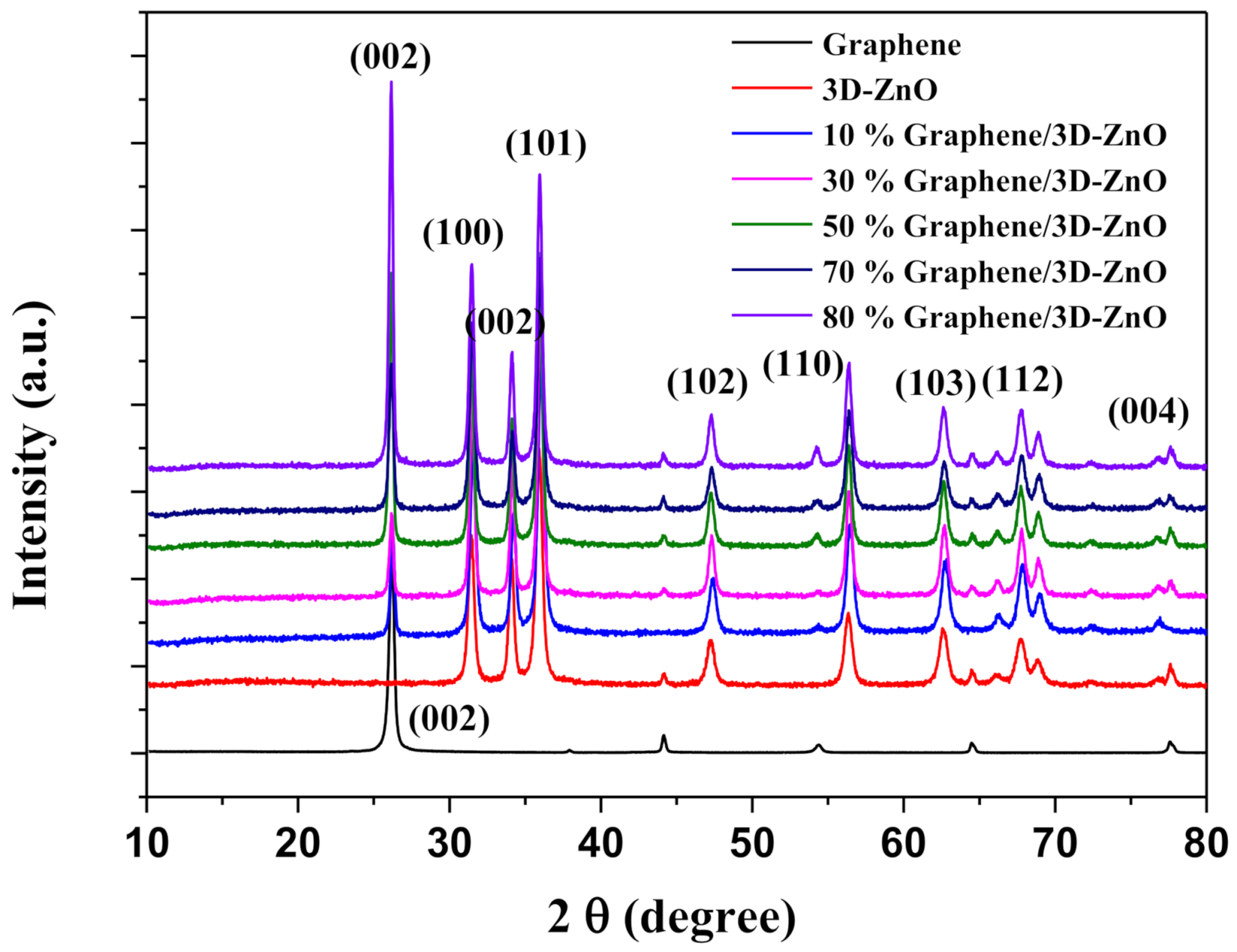

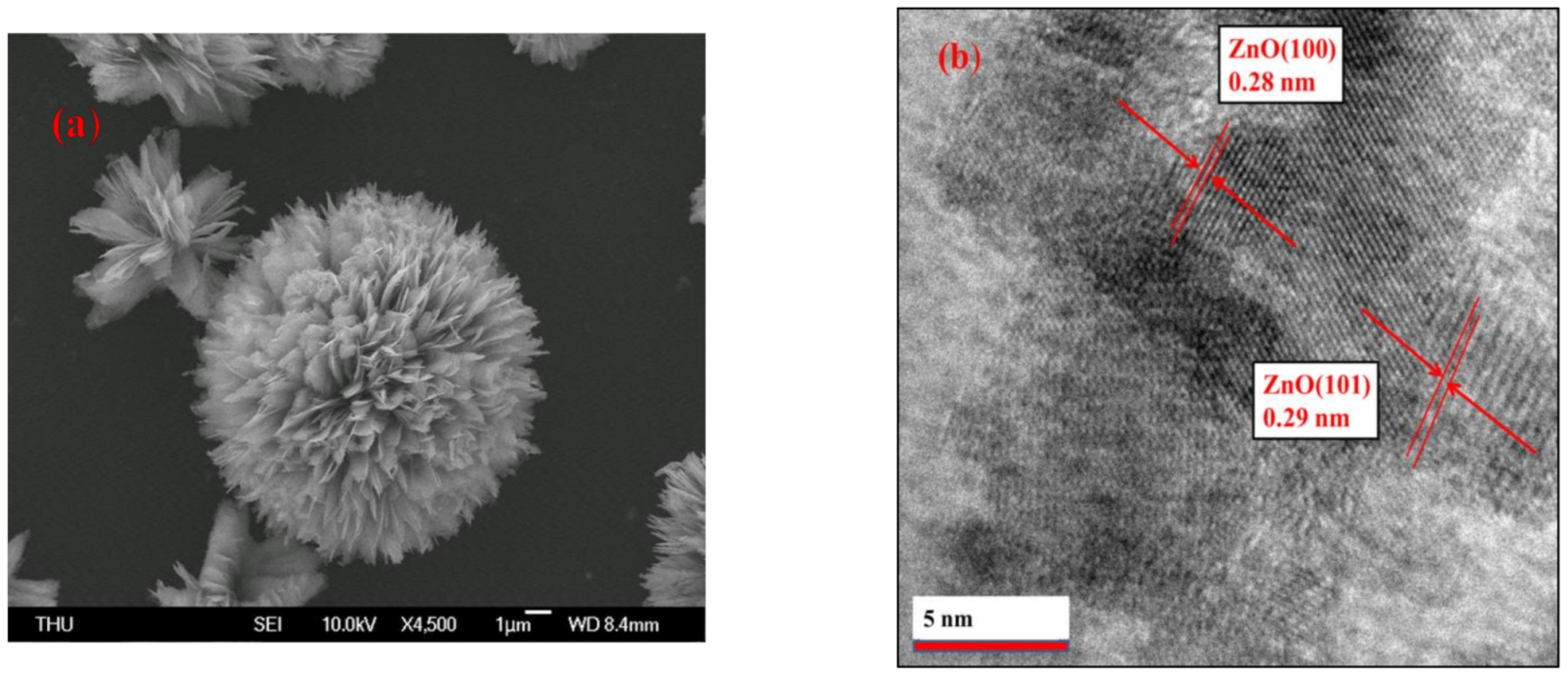
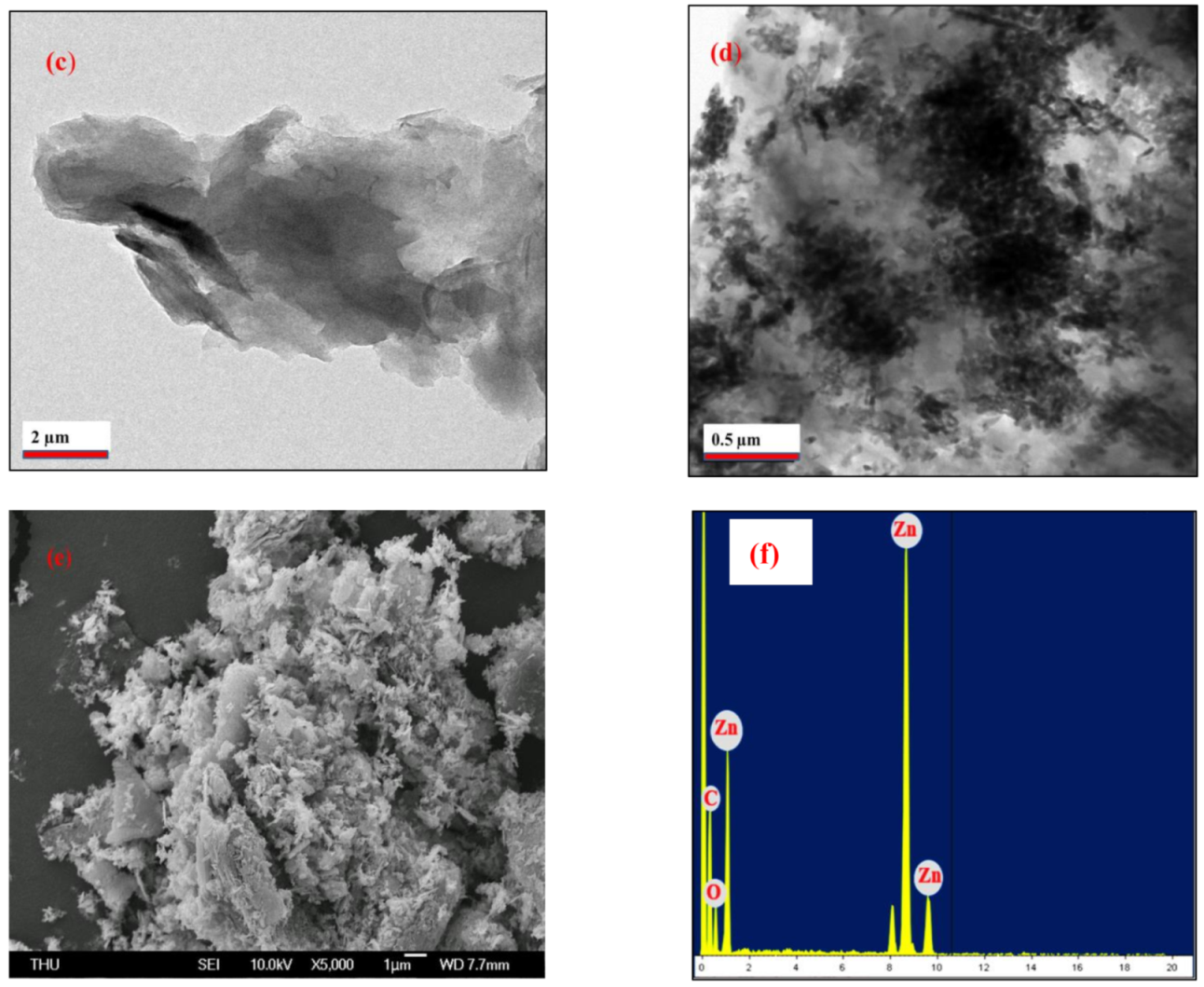
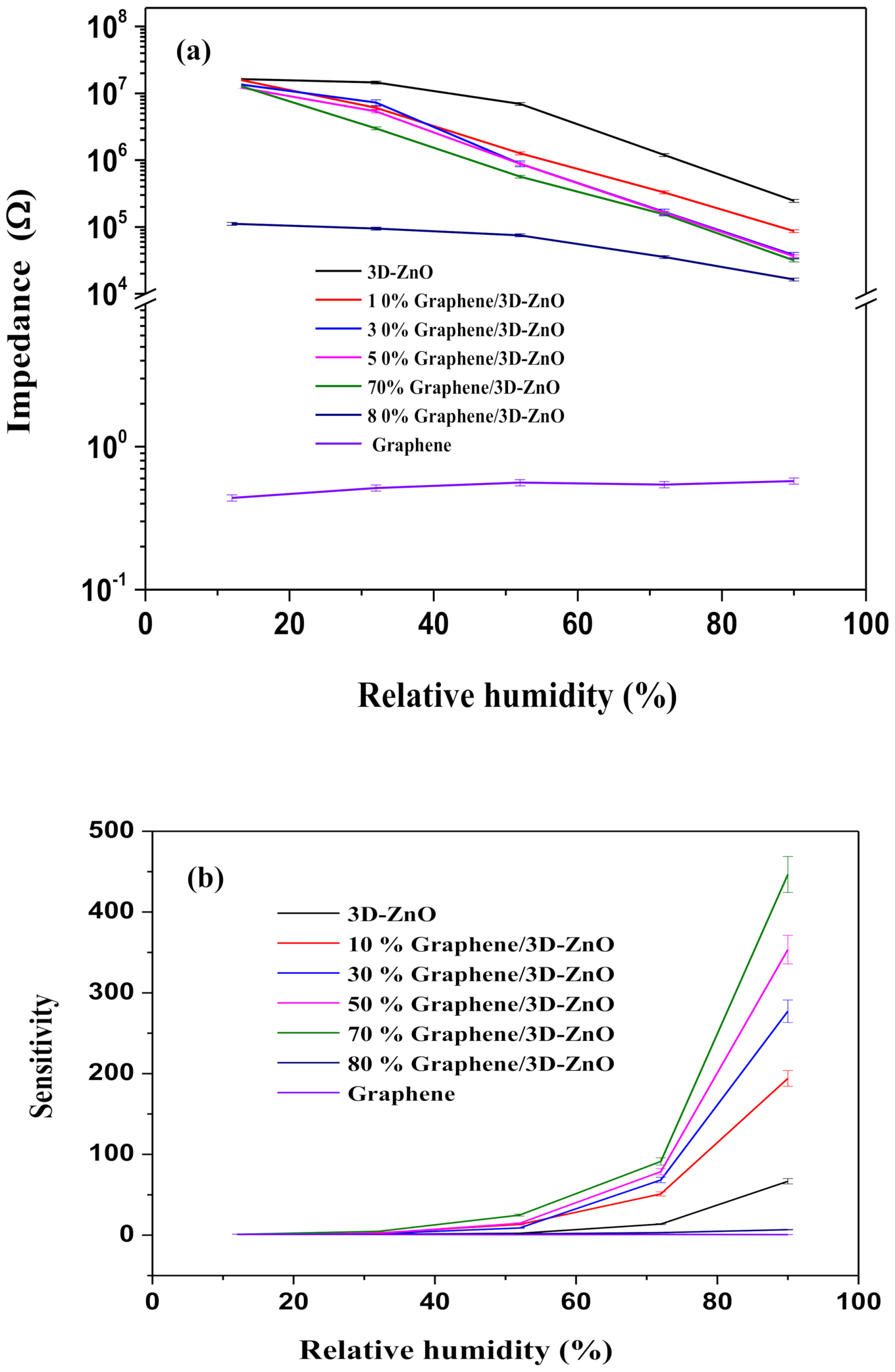
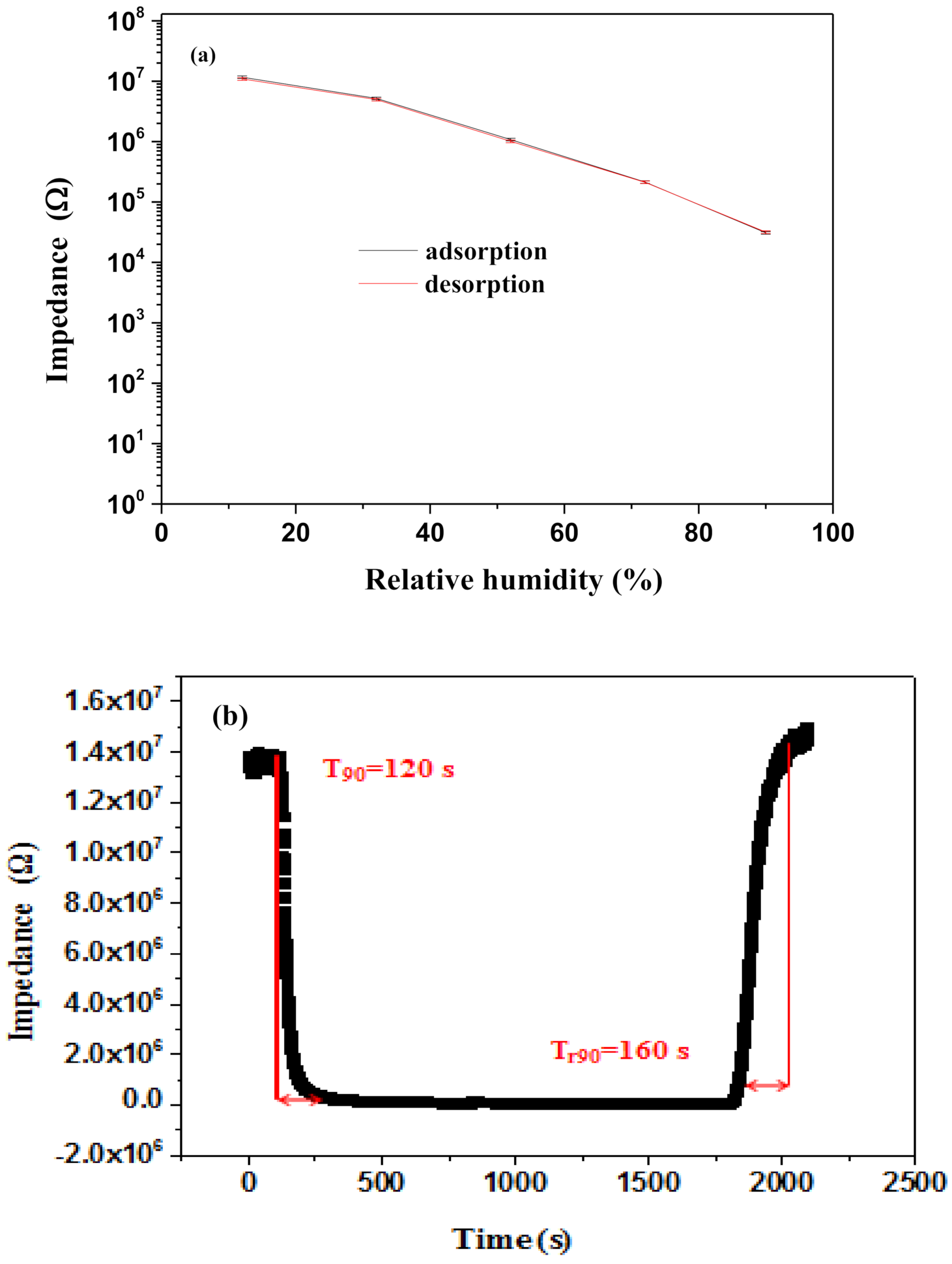

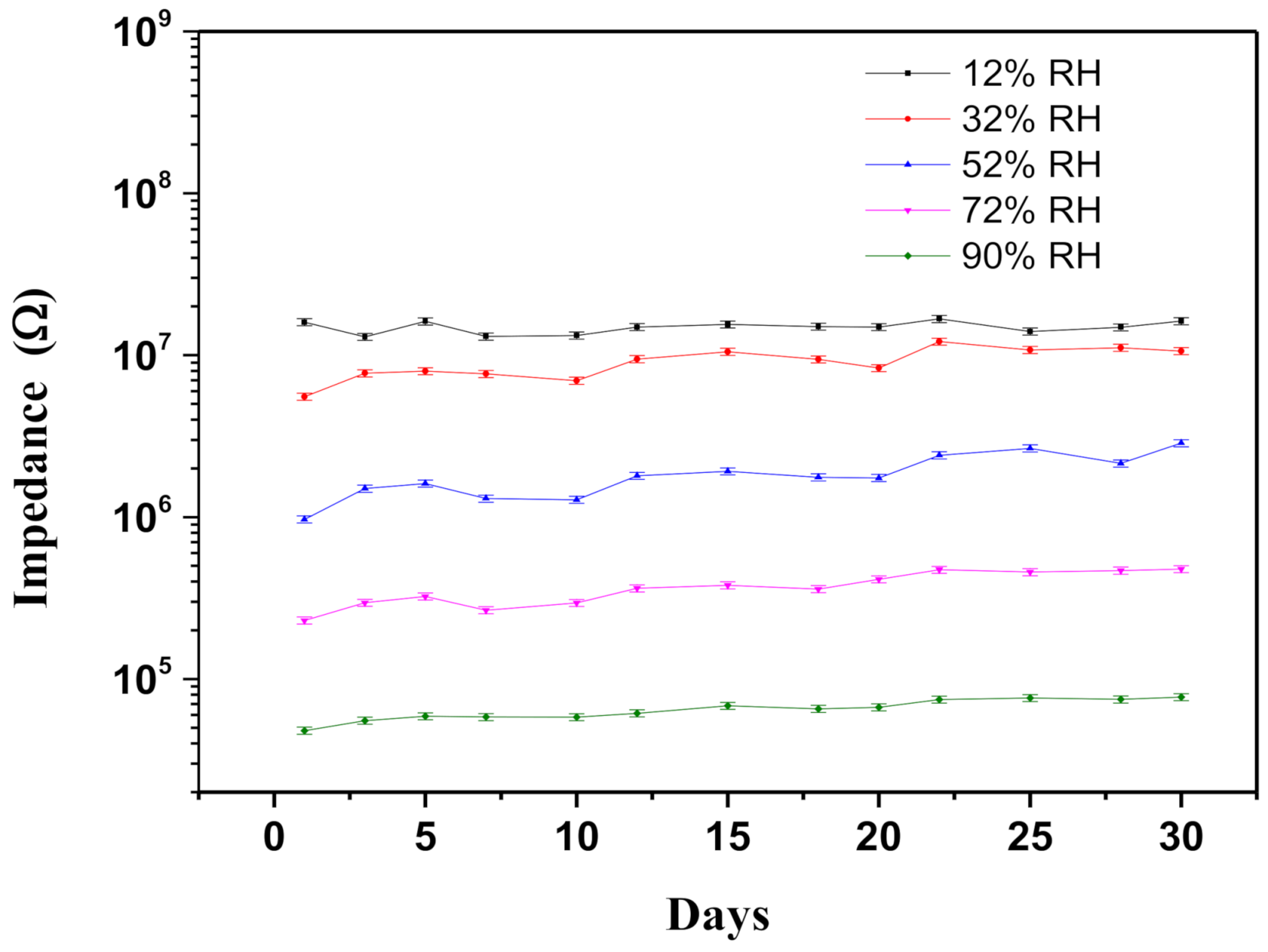

| Sensing Material | Measurement Range (% RH.) | Response Time (s) | Recovery Time (s) | References |
|---|---|---|---|---|
| ZnO nanowires | 11–97 | 35.3 | 32.6 | [17] |
| PVDF/ZnO nanocomposites | 5–95 | 30 | 50 | [24] |
| ZnO nanosheets | 12–96 | 600 | 3 | [54] |
| Sn-doped ZnO nanorod | 40–90 | 230 | 30 | [55] |
| LiCl-doped ZnO electrospun nanofibers | 11–95 | 3 | 6 | [56] |
| ZnO colloid crystals | 5–98 | 152 | 10 | [57] |
| Gr/3D–ZnO nanocomposites | 12–90 | 120 | 160 | This work |
Publisher’s Note: MDPI stays neutral with regard to jurisdictional claims in published maps and institutional affiliations. |
© 2021 by the authors. Licensee MDPI, Basel, Switzerland. This article is an open access article distributed under the terms and conditions of the Creative Commons Attribution (CC BY) license (https://creativecommons.org/licenses/by/4.0/).
Share and Cite
Lin, W.-D.; Lin, Y.-C.; Wu, R.-J.; Chavali, M. Gr/3D–ZnO Nanocomposites as Humidity Sensors with Enhanced Sensing Response. Polymers 2021, 13, 1623. https://doi.org/10.3390/polym13101623
Lin W-D, Lin Y-C, Wu R-J, Chavali M. Gr/3D–ZnO Nanocomposites as Humidity Sensors with Enhanced Sensing Response. Polymers. 2021; 13(10):1623. https://doi.org/10.3390/polym13101623
Chicago/Turabian StyleLin, Wang-De, You-Chen Lin, Ren-Jang Wu, and Murthy Chavali. 2021. "Gr/3D–ZnO Nanocomposites as Humidity Sensors with Enhanced Sensing Response" Polymers 13, no. 10: 1623. https://doi.org/10.3390/polym13101623
APA StyleLin, W.-D., Lin, Y.-C., Wu, R.-J., & Chavali, M. (2021). Gr/3D–ZnO Nanocomposites as Humidity Sensors with Enhanced Sensing Response. Polymers, 13(10), 1623. https://doi.org/10.3390/polym13101623







